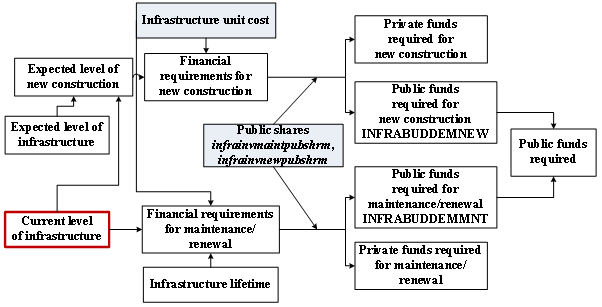International Futures Help System
Translating the Expected Levels of Infrastructure into Financial Requirements
In estimating the financial requirements to achieve the expected levels of infrastructure, we adopt the approach introduced by Fay (2001) and Fay and Yepes (2003) described earlier. In this approach, there are two components to the financial requirements for each type of infrastructure each year. First there is the cost of maintenance/renewal of existing infrastructure. Second, there is the cost of new construction. These then need to be separated into public and private shares. The following figure shows the general process for each type of infrastructure.

Estimating the financial requirements for new construction
For each type of infrastructure, the existing level of physical infrastructure is subtracted from the forecasted level and the difference is multiplied by the unit cost (see the table below for the list of the parameters that store the information on the unit costs). The results are then summed across the different types of infrastructure to calculate the total demand for funding for new construction. In a slight variation, rather than calculate the growth of the physical stock, Stambrook (2006) first calculated the asset value of the existing road stock by multiplying the level of the physical stock by a unit cost. He then directly forecasted the growth of this asset value, which was assumed to be equal to the investment requirements.
Estimating the financial requirements for maintenance/renewal
Although we use the term “maintenance” for this second set of infrastructure funding requirements, different studies use different nomenclature. Bhattacharyay (2010), Fay and Yepes (2003), Kohli and Basil (2011), and Yepes (2005), all use “maintenance”; Chatterton and Puerto (2006) refer to “rehabilitation.” Yepes (2008) refers to “maintenance and rehabilitation.” Finally, G. Hughes, Chinowsky, and Strzepek (2009) provide separate estimates for replacement and for maintenance. In general, however, the methodology for the estimation of the funding requirements is the same across all studies. For each type of infrastructure, the funding is determined as a percentage of the dollar value of the existing infrastructure. The dollar value is given as the amount of infrastructure in physical units multiplied by the same unit cost used for estimating the funding for new construction. The percentage is based on the average lifetime of the particular infrastructure (see Table 6 for the list of the parameters that store the infrastructure lifetimes in IFs). Fay and Yepes (2003: 10) referred to this as “the minimum annual average expenditure on maintenance, below which the network’s functionality will be threatened.” Later authors have more specifically related the percentage to the depreciation rate or average expected lifetime of each type of infrastructure (Chatterton and Puerto 2006; Yepes 2005, 2008).
Separating the financial requirements into public and private shares
In the real world funding for infrastructure comes from both public and private sources, so we separate the funding requirements into public and private components. We assume a specific share of public and private funding for each type of infrastructure. This, in effect, implies that public spending on infrastructure leverages a certain amount of private spending. These shares differ by type of infrastructure, but are constant across countries and time. The share parameters are infrainvmaintpubshrm and infrainvnewpubshrm , each of which is a vector, with the dimension representing the type of infrastructure. The balancing of the financial requirements with the available resources included in IFs and described in the next section only considers the public sector.
| Infrastructure Type (unit) | Unit Cost Parameters[1] | Lifetime Parameter |
| Paved road (kilometer) | infraroadpavedcostlower, infraroadpavedcostm, infraroadpavedcostupper | infraroadpavedlife |
| Unpaved road (kilometer) | infraroadunpavedcostlower, infraroadunpavedcostm, infraroadunpavedcostupper | infraroadunpavedlife |
| Electricity generation (megawatt) | infraelecgencostlower, infraelecgencostm, infraelecgencostupper | infraelecgenlife |
| Rural electricity (connection) | infraelecaccruralcostlower, infraelecaccruralcostm, infraelecaccruralcostupper | infraelecaccrurallife |
| Urban electricity (connection) | infraelecaccurbancostlower, infraelecaccurbancostm, infraelecaccurbancostupper | infraelecaccurbanlife |
| Irrigation equipment (hectare) | landircostlower, landircostm, landircostupper | landirlife |
| Improved water (connection) | watsafeimpcostlower, watsafeimpcostm, watsafeimpcostupper | watsafeimplife |
| Piped water (connection) | watsafecostlower, watsafecostm, watsafecostupper | watsafelife |
| Shared sanitation (connection) | sanitationimpcostlower, sanitationimpcostm, sanitationimpcostupper | sanitationimplife |
| Improved sanitation (connection) | sanitationcostlower, sanitationcostm, sanitationcostupper | sanitationlife |
| Wastewater treatment (connection) | watwastetreatcostlower, watwastetreatcostm, watwastetreatcostupper | watwastetreatlife |
| Fixed telephone (line) | infratelecostlower, infratelecostm, infratelecostupper | infratelelife |
| Fixed broadband (subscription) | ictbroadcostlower, ictbroadcostm, ictbroadcostupper | ictbroadlife |
| Mobile phone (subscription) | ictmobilcostlower, ictmobilcostm, ictmobilcostupper | ictmobillife |
| Mobile broadband (subscription) | ictbroadmobilcostlower, ictbroadmobilcostm, ictbroadmobilcostupper | ictbroadmobillife |
|
[1] The actual unit costs can change as a function of GDP per capita (GDPPCP). For a given type of infrastructure, below a given level of GDPPCP, the unit cost takes on the value specified by the parameter ending with ‘lower’. Above a given level of GDPPCP, the unit cost takes on the value specified by the parameter ending with ‘upper’. Between these two values of GDPPCP, the unit cost changes in a linear fashion between the ‘lower’ and ‘upper’ value as a function of GDPPCP. Currently, the lower and upper thresholds for GDPPCP are hard coded in the model and vary by type of infrastructure. [2] The unit cost parameters ending in ‘m’ are multipliers that can be used to change the unit cost directly. [3] As described in the discussion on initializing the infrastructure data for IFs, the unit costs are also multiplied by the variable INFRACOSTADJFAC, which is calculated in the first year of the model as part of balancing the government spending in that year. This variable always has a value between 0 and 1, and gradually converges to 1 over the time period given by the parameter infracostadjfacconvtime . |
||
 International Futures at the Pardee Center
International Futures at the Pardee Center